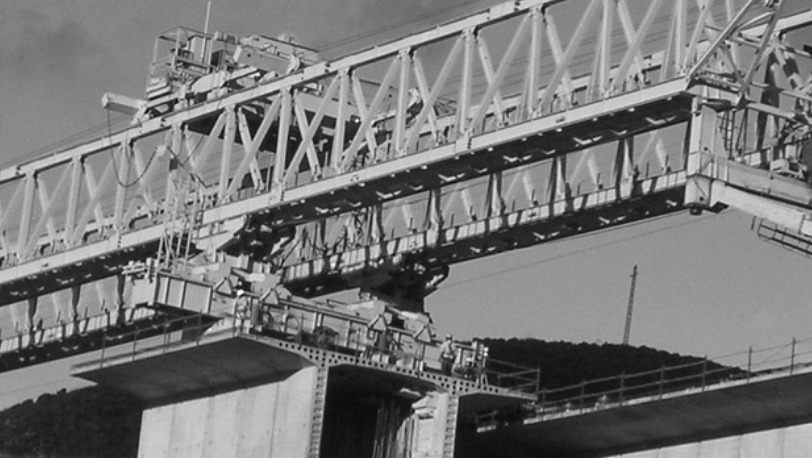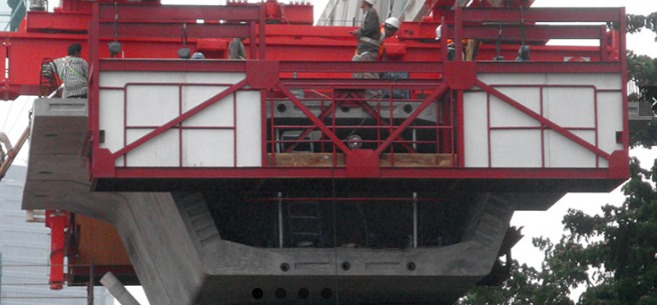Our Construction Methods
ESPT specializes in various bridge construction methods to meet the specific requirements of each project. Below are the key techniques we employ for efficient and reliable bridge construction.

Balanced Cantilever

Span-by-span Method
Detailed Construction Methods
Span-by-span lifting and launching
Span-by-span lifting and launching is a construction method commonly used for building long-span bridges, particularly precast segmental bridges. This technique involves assembling and installing an entire span of the bridge at once, using specialized equipment like launching gantries or lifting frames.
How It Works 1.Precasting Segments: The bridge segments are precast in a controlled environment, ensuring high quality and precision. 2.Transporting Segments: These segments are transported to the construction site. 3.Lifting and Assembling: Using a launching gantry, the segments are lifted and assembled span by span. The gantry moves forward to the next span after completing one. 4.Post-Tensioning: Once the segments are in place, they are post-tensioned to ensure structural integrity.
Advantages Efficiency: The method allows for rapid construction, with multiple spans completed in a short time. Minimal Disruption: It reduces the impact on traffic or the environment below the bridge. Cost-Effectiveness: Precasting and repetitive processes lower overall costs.
Applications Span-by-span launching is ideal for bridges with multiple spans of uniform length, such as viaducts or highway overpasses. It is particularly effective for spans ranging from 25 to 50 meters.


Balanced cantilever
Balanced cantilever launching is a construction method used for bridges, where segments are added symmetrically on either side of a pier to maintain balance. This technique is ideal for long-span bridges and challenging terrains.
How It Works 1.Pier Table Construction: The process begins with the construction of a pier table, which serves as the base for cantilevering. 2.Segment Placement: Precast or cast-in-place segments are added alternately on both sides of the pier, ensuring the structure remains balanced. 3.Post-Tensioning: Each segment is post-tensioned to enhance stability and structural integrity. 4.Progression: The cantilever extends outward until it meets the cantilever from the adjacent pier or reaches the span's end.
Advantages Adaptability: Suitable for bridges with variable spans or complex geometries. Minimal Disruption: Reduces impact on the environment or traffic below the bridge. Precision: Ensures accurate alignment and structural balance.
Applications Balanced cantilever launching is commonly used for: Highway Bridges: Spanning rivers or valleys. Railway Bridges: Over difficult terrains. Cable-Stayed Bridges: Incorporating cantilever techniques for deck construction.
Balanced cantilever construction with lifting frames
Balanced cantilever construction with lifting frames is an advanced method used for building bridges, particularly in challenging terrains or over obstacles like rivers and highways.
How It Works 1.Segment Preparation: Precast segments are fabricated off-site or near the construction area. 2.Lifting Frames: Specialized lifting frames are installed on the piers. These frames are designed to lift and position the segments precisely. 3.Segment Placement: Segments are lifted and placed symmetrically on either side of the pier to maintain balance. 4.Post-Tensioning: Once the segments are in place, they are post-tensioned to ensure structural stability and integrity. 5.Progression: The lifting frames move forward to the next segment, repeating the process until the span is complete.
Advantages Precision: Lifting frames allow for accurate placement of segments, ensuring structural alignment. Adaptability: This method is suitable for long spans and complex geometries. Efficiency: The use of lifting frames reduces the need for heavy cranes and minimizes disruption to the environment or traffic below.
Applications This technique is commonly used for: Highway Bridges: Spanning over busy roads or rivers. Railway Bridges: In areas with limited access. Cable-Stayed Bridges: Where balanced cantilever methods complement the design.


Balanced cantilever construction with a launching gantry
Balanced cantilever construction with a launching gantry is a highly efficient method for building long-span bridges, particularly in challenging terrains or over obstacles like rivers and highways.
How It Works 1.Segment Preparation: Precast segments are fabricated off-site or near the construction area. 2.Launching Gantry Setup: A specialized launching gantry is installed on the piers. This gantry is designed to lift, position, and support the segments during construction. 3.Segment Placement: Segments are lifted and placed symmetrically on either side of the pier to maintain balance. The gantry moves forward as each segment is installed. 4.Post-Tensioning: Once the segments are in place, they are post-tensioned to ensure structural stability and integrity. 5.Progression: The process continues until the cantilevers from adjacent piers meet or the span is complete.
Advantages Precision: The launching gantry ensures accurate placement of segments, maintaining structural alignment. Efficiency: This method allows for rapid construction, reducing overall project timelines. Minimal Disruption: The gantry operates above the terrain, minimizing impact on the environment or traffic below. Adaptability: Suitable for long spans and complex geometries, including curved alignments.
Applications This technique is commonly used for: Highway Bridges: Spanning over busy roads or rivers. Railway Bridges: In areas with limited access. Cable-Stayed Bridges: Where balanced cantilever methods complement the design.
Precast girder erection launchers
Precast girder erection launchers are specialized equipment used in bridge construction to lift, position, and install precast girders efficiently and accurately. These launchers are particularly useful for projects involving long spans or challenging terrains.
How Precast Girder Erection Launchers Work 1.Preparation: Precast girders are fabricated off-site and transported to the construction site. 2.Launcher Setup: The launcher is positioned on the bridge piers or abutments. 3.Lifting and Placement: Using hydraulic systems or winches, the launcher lifts the girder and places it precisely onto the supports. 4.Alignment and Securing: The girder is aligned and secured in place, ensuring structural stability.
Advantages Efficiency: Reduces construction time by enabling rapid installation of girders. Precision: Ensures accurate placement, minimizing the need for adjustments. Safety: Reduces the reliance on heavy cranes, enhancing safety on-site. Adaptability: Suitable for various girder types, including I-girders, U-girders, and T-girders.
Applications Precast girder erection launchers are commonly used for: Highway Bridges: Spanning over roads or rivers. Railway Bridges: In areas with limited access. Urban Infrastructure: Where space constraints require efficient construction methods.
